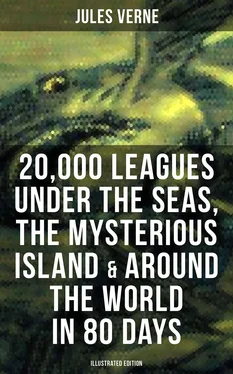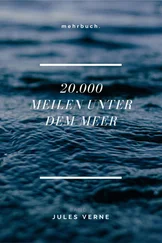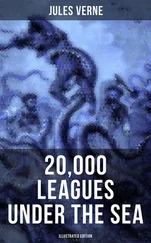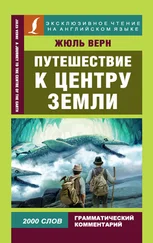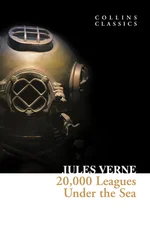I showed Conseil the position of this long reef on our chart of the Mediterranean.
“But with all due respect to master,” Conseil ventured to observe, “it’s like an actual isthmus connecting Europe to Africa.”
“Yes, my boy,” I replied, “it cuts across the whole Strait of Sicily, and Smith’s soundings prove that in the past, these two continents were genuinely connected between Cape Boeo and Cape Farina.”
“I can easily believe it,” Conseil said.
“I might add,” I went on, “that there’s a similar barrier between Gibraltar and Ceuta, and in prehistoric times it closed off the Mediterranean completely.”
“Gracious!” Conseil put in. “Suppose one day some volcanic upheaval raises these two barriers back above the waves!”
“That’s most unlikely, Conseil.”
“If master will allow me to finish, I mean that if this phenomenon occurs, it might prove distressing to Mr. de Lesseps, who has gone to such pains to cut through his isthmus!”
“Agreed, but I repeat, Conseil: such a phenomenon won’t occur. The intensity of these underground forces continues to diminish. Volcanoes were quite numerous in the world’s early days, but they’re going extinct one by one; the heat inside the earth is growing weaker, the temperature in the globe’s lower strata is cooling appreciably every century, and to our globe’s detriment, because its heat is its life.”
“But the sun—”
“The sun isn’t enough, Conseil. Can it restore heat to a corpse?”
“Not that I’ve heard.”
“Well, my friend, someday the earth will be just such a cold corpse. Like the moon, which long ago lost its vital heat, our globe will become lifeless and unlivable.”
“In how many centuries?” Conseil asked.
“In hundreds of thousands of years, my boy.”
“Then we have ample time to finish our voyage,” Conseil replied, “if Ned Land doesn’t mess things up!”
Thus reassured, Conseil went back to studying the shallows that the Nautilus was skimming at moderate speed.
On the rocky, volcanic seafloor, there bloomed quite a collection of moving flora: sponges, sea cucumbers, jellyfish called sea gooseberries that were adorned with reddish tendrils and gave off a subtle phosphorescence, members of the genus Beroe that are commonly known by the name melon jellyfish and are bathed in the shimmer of the whole solar spectrum, free-swimming crinoids one meter wide that reddened the waters with their crimson hue, treelike basket stars of the greatest beauty, sea fans from the genus Pavonacea with long stems, numerous edible sea urchins of various species, plus green sea anemones with a grayish trunk and a brown disk lost beneath the olive-colored tresses of their tentacles.
Conseil kept especially busy observing mollusks and articulates, and although his catalog is a little dry, I wouldn’t want to wrong the gallant lad by leaving out his personal observations.
From the branch Mollusca, he mentions numerous comb-shaped scallops, hooflike spiny oysters piled on top of each other, triangular coquina, three-pronged glass snails with yellow fins and transparent shells, orange snails from the genus Pleurobranchus that looked like eggs spotted or speckled with greenish dots, members of the genus Aplysia also known by the name sea hares, other sea hares from the genus Dolabella, plump paper-bubble shells, umbrella shells exclusive to the Mediterranean, abalone whose shell produces a mother-of-pearl much in demand, pilgrim scallops, saddle shells that diners in the French province of Languedoc are said to like better than oysters, some of those cockleshells so dear to the citizens of Marseilles, fat white venus shells that are among the clams so abundant off the coasts of North America and eaten in such quantities by New Yorkers, variously colored comb shells with gill covers, burrowing date mussels with a peppery flavor I relish, furrowed heart cockles whose shells have riblike ridges on their arching summits, triton shells pocked with scarlet bumps, carniaira snails with backward-curving tips that make them resemble flimsy gondolas, crowned ferola snails, atlanta snails with spiral shells, gray nudibranchs from the genus Tethys that were spotted with white and covered by fringed mantles, nudibranchs from the suborder Eolidea that looked like small slugs, sea butterflies crawling on their backs, seashells from the genus Auricula including the oval-shaped Auricula myosotis, tan wentletrap snails, common periwinkles, violet snails, cineraira snails, rock borers, ear shells, cabochon snails, pandora shells, etc.
As for the articulates, in his notes Conseil has very appropriately divided them into six classes, three of which belong to the marine world. These classes are the Crustacea, Cirripedia, and Annelida.
Crustaceans are subdivided into nine orders, and the first of these consists of the decapods, in other words, animals whose head and thorax are usually fused, whose cheek-and-mouth mechanism is made up of several pairs of appendages, and whose thorax has four, five, or six pairs of walking legs. Conseil used the methods of our mentor Professor Milne-Edwards, who puts the decapods in three divisions: Brachyura, Macrura, and Anomura. These names may look a tad fierce, but they’re accurate and appropriate. Among the Brachyura, Conseil mentions some amanthia crabs whose fronts were armed with two big diverging tips, those inachus scorpions that— lord knows why—symbolized wisdom to the ancient Greeks, spider crabs of the massena and spinimane varieties that had probably gone astray in these shallows because they usually live in the lower depths, xanthid crabs, pilumna crabs, rhomboid crabs, granular box crabs (easy on the digestion, as Conseil ventured to observe), toothless masked crabs, ebalia crabs, cymopolia crabs, woolly-handed crabs, etc. Among the Macrura (which are subdivided into five families: hardshells, burrowers, crayfish, prawns, and ghost crabs) Conseil mentions some common spiny lobsters whose females supply a meat highly prized, slipper lobsters or common shrimp, waterside gebia shrimp, and all sorts of edible species, but he says nothing of the crayfish subdivision that includes the true lobster, because spiny lobsters are the only type in the Mediterranean. Finally, among the Anomura, he saw common drocina crabs dwelling inside whatever abandoned seashells they could take over, homola crabs with spiny fronts, hermit crabs, hairy porcelain crabs, etc.
There Conseil’s work came to a halt. He didn’t have time to finish off the class Crustacea through an examination of its stomatopods, amphipods, homopods, isopods, trilobites, branchiopods, ostracods, and entomostraceans. And in order to complete his study of marine articulates, he needed to mention the class Cirripedia, which contains water fleas and carp lice, plus the class Annelida, which he would have divided without fail into tubifex worms and dorsibranchian worms. But having gone past the shallows of the Strait of Sicily, the Nautilus resumed its usual deep-water speed. From then on, no more mollusks, no more zoophytes, no more articulates. Just a few large fish sweeping by like shadows.
During the night of February 16-17, we entered the second Mediterranean basin, whose maximum depth we found at 3,000 meters. The Nautilus, driven downward by its propeller and slanting fins, descended to the lowest strata of this sea.
There, in place of natural wonders, the watery mass offered some thrilling and dreadful scenes to my eyes. In essence, we were then crossing that part of the whole Mediterranean so fertile in casualties. From the coast of Algiers to the beaches of Provence, how many ships have wrecked, how many vessels have vanished! Compared to the vast liquid plains of the Pacific, the Mediterranean is a mere lake, but it’s an unpredictable lake with fickle waves, today kindly and affectionate to those frail single-masters drifting between a double ultramarine of sky and water, tomorrow bad-tempered and turbulent, agitated by the winds, demolishing the strongest ships beneath sudden waves that smash down with a headlong wallop.
Читать дальше
